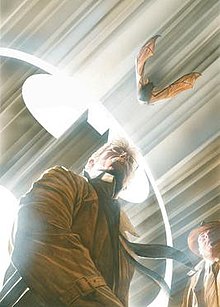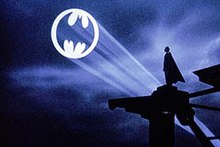
Gotham City, also simply known as Gotham, is a fictional city in the Eastern United States that serves as the primary city appearing in American comic books published by DC Comics. It was best known as the home of the superhero, Batman, and his allies and foes. Created by writer Bill Finger and artist Bob Kane, the city was first identified as Batman's place of residence in Batman #4 and has since been the primary setting for stories featuring the character. In most of its incarnations, Gotham is depicted as one of the most crime-ridden cities in the world.
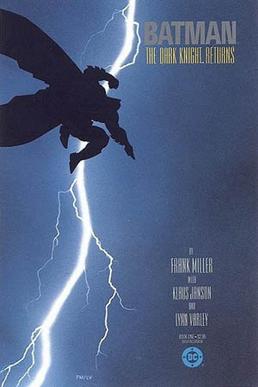
The Dark Knight Returns is a 1986 four-issue comic book miniseries starring Batman, written by Frank Miller, illustrated by Miller and Klaus Janson, with color by Lynn Varley, and published by DC Comics. It tells an alternative story of Bruce Wayne, who at 55 years old returns from retirement to fight crime while facing opposition from the Gotham City police force and the United States government. The story also features the return of classic foes Two-Face and the Joker, and culminates with a confrontation with Superman, who is now a pawn of the government.

The Elizabeth Arkham Asylum for the Criminally Insane, commonly referred to as Arkham Asylum, is a fictional psychiatric hospital/prison, appearing in American comic books published by DC Comics, commonly in stories featuring the superhero Batman. It first appeared in Batman #258, written by Dennis O'Neil with art by Irv Novick. The asylum serves as a (forensic) psychiatric hospital for the Gotham City area, housing patients who are criminally insane, as well as select prisoners with unusual medical requirements that are beyond a conventional prison's ability to accommodate. Its high-profile patients are often members of Batman's rogues gallery.

The Scarecrow is a supervillain appearing in American comic books published by DC Comics. Created by Bill Finger and Bob Kane, the character first appeared in World's Finest Comics #3, and has become one of the superhero Batman's most enduring enemies belonging to the collective of adversaries that make up his rogues gallery.

James W. "Jim" Gordon is a fictional character appearing in American comic books published by DC Comics, most commonly in association with the superhero Batman. Created by Bill Finger and Bob Kane as an ally of Batman, the character debuted in the first panel of Detective Comics #27, Batman's first appearance, making him the first Batman supporting character ever to be introduced.

Lucius Fox is a character appearing in American comic books published by DC Comics, commonly in association with the superhero Bruce Wayne / Batman. He is Wayne's business manager at Wayne Enterprises who runs the business interests that supply his equipment needs as well as financing his operations, and is the father of Luke Fox / Batwing, Tiffany Fox / Batgirl, and Jace Fox / Batman.

The Batman is an American animated television series based on the DC Comics superhero Batman. Developed by Michael Goguen and Duane Capizzi, and produced by Warner Bros. Animation, the series first aired on Kids' WB on September 11, 2004, then Cartoon Network on April 2, 2005. The show would become exclusive to the former network for its third, fourth, and fifth seasons in early 2006. The Batman won six Daytime Emmy Awards over the course of its run. Many elements from previous Batman storylines were borrowed and adapted, such as those from the comic books, film series and the animated shows like Batman: The Animated Series from the DC Animated Universe, but it remained strictly within its own distinct continuity. Jackie Chan Adventures artist Jeff Matsuda served as art director and provided the character designs. The production team altered the appearances of many of the comic books' supervillains for the show, such as the Joker, the Penguin, Mr. Freeze, and the Riddler.

Harvey Bullock is a fictional detective appearing in American comic books published by DC Comics, commonly in association with the superhero Batman. The character first appeared in Detective Comics #441 and was created by Archie Goodwin and Howard Chaykin. In animation, he appeared throughout the DC Animated Universe, voiced by Robert Costanzo. He debuted in live-action in 2014 on Fox's television series Gotham, portrayed by Donal Logue.

Gillian B. Loeb is a fictional character in the DC Universe who serves as an enemy to Batman's ally James "Jim" Gordon in DC Comics publications.
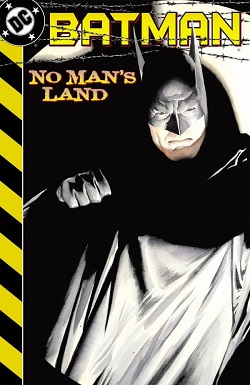
"Batman: No Man's Land" is an American comic book crossover storyline that ran for almost all of 1999 through the Batman comic book titles published by DC Comics. The story architecture for "No Man's Land" and the outline of all the Batman continuity titles for 1999 were written by cartoonist Jordan B. Gorfinkel.

The Batplane, Batwing, Batjet or Batgyro is the fictional aircraft for the DC Comics superhero Batman. The vehicle was introduced in "Batman Versus The Vampire, I", published in Detective Comics #31 in 1939, a story which saw Batman travel to continental Europe. In this issue it was referred to as the "Batgyro", and according to Les Daniels was "apparently inspired by Igor Sikorsky's first successful helicopter flight" of the same year. Initially based upon either an autogyro or helicopter, with a rotor, the Batgyro featured a bat motif at the front. The writers gave the Batgyro the ability to be "parked" in the air by Batman, hovering in such a way as to maintain its position and allow Batman to return.
Originally created in 1967, the fictional comic book character Barbara Gordon has been adapted into various other forms of media. The character has appeared in both live action and animated television series and films, as well as in video games in her alter-egos as both Batgirl and Oracle!.
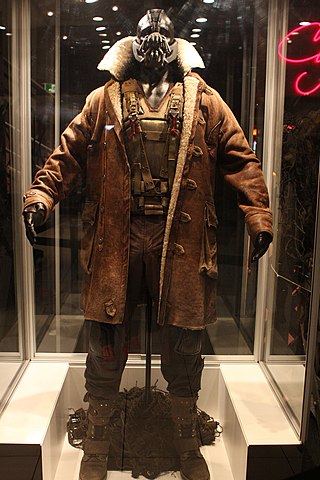
Bane was originally a comic book character and Batman's adversary, but has appeared in several other forms of media. He has been portrayed in live action by Robert Swenson in Batman & Robin, Tom Hardy in The Dark Knight Rises, and Shane West in Gotham. Henry Silva, Héctor Elizondo, Joaquim de Almeida, Ron Perlman, Clancy Brown, Michael Dorn, Danny Trejo, Carlos Alazraqui, Fred Tatasciore, Jason Liebrecht, Steve Blum, JB Blanc, Doug Benson, James Adomian, and Peter Marinker have all provided voice work for the character.

Batman: The Dark Knight Returns is a two-part direct-to-video adult animated superhero film, an adaptation of the 1986 comic book The Dark Knight Returns by Frank Miller and is set in the same continuity as Batman: Year One. It was directed by Jay Oliva, who worked as a storyboard artist on Man of Steel, Under the Red Hood, Year One and Batman v Superman: Dawn of Justice. Several other Batman veterans were also involved in the film. Part 1 was released on September 25, 2012, and Part 2 was released on January 29, 2013. A deluxe edition combining both films was released on October 8, 2013. Part 1 is the 15th film, and Part 2 is the 16th film, of the DC Universe Animated Original Movies.

Batman: The Enemy Within is an episodic point-and-click graphic adventure video game developed and published by Telltale Games and distributed by Warner Bros. Interactive Entertainment under its DC Entertainment label, based on the DC Comics character Batman. The game is a sequel to 2016's Batman: The Telltale Series. It received positive reviews, and is viewed as an improvement over the original, with the game's depiction of the Joker.

The Riddler, a supervillain in DC Comics and an adversary of the superhero Batman, has been adapted into numerous forms of media, including feature films, television series, and video games. The character has been portrayed in live-action by Frank Gorshin and John Astin in the 1960s television series Batman, Jim Carrey in the 1995 film Batman Forever, Cory Michael Smith in the 2014 Fox series Gotham, and Paul Dano in the 2022 film The Batman. Actors who have voiced the Riddler include John Glover in the DC Animated Universe, Robert Englund in The Batman, and Wally Wingert in the Batman: Arkham video games.

Duke Thomas is a fictional character appearing in comics published by DC Comics. He was created by Scott Snyder and Greg Capullo. He was introduced as a supporting character of Batman, his first appearance being in 2013 in Batman #21, before later leading a youth vigilante movement inspired by Robin, in the comic book We Are... Robin, in May 2015. He officially became Batman's newest partner and joined the Batman family in 2016.

The character Two-Face was created by Bob Kane and first appeared in Detective Comics #66. However, he did not appear outside comics until half a century later in Batman: The Animated Series. Two-Face has since been substantially adapted from the comics into various forms of media, such as feature films, television series and video games. Two-Face has been voiced by Richard Moll in the DC Animated Universe, Troy Baker in the Batman: Arkham series, Billy Dee Williams in The Lego Batman Movie, and William Shatner in Batman vs. Two-Face. His live-action portrayals include Billy Dee Williams in Batman (1989), Tommy Lee Jones in Batman Forever, Aaron Eckhart in The Dark Knight, and Nicholas D'Agosto in the television series Gotham. In 2009, Two-Face was ranked #12 on IGN's list of the Top 100 Comic Book Villains of All Time.

Bruce Wayne, also known by his vigilante persona Batman, is a fictional character who is the main protagonist in Christopher Nolan's trilogy of superhero films, based on the DC Comics character of the same name, created by Bill Finger and Bob Kane. Portrayed by Christian Bale, this version of Batman is arguably explored more in-depth compared to that of the previous film series by Tim Burton and Joel Schumacher, as the Dark Knight film series provides a full arc for the character and was intended by Nolan to be more realistic than previous portrayals.
